Overview of the Role of Energy Resources in Algeria’s Energy Transition
Abstract
:1. Introduction
2. Research Methodology
- -
- IEEE and other conferences.
- -
- Government publications related to the Algeria Ministry of Energy, Ministry of Water Resources of Algeria, National Sanitation Office, National Waste Management Agency, etc.
- -
- Energy Information Administration EIA, British Petroleum (BP), International Energy Agency (IEA), United Nations, World Water Assessment Programme (WWAP), International Renewable Energy Agency (IRENA).
- -
- Newspaper and legislation (the Algerian Official Journal).
- -
- Miscellaneous (dissertations, books, websites, magazines).
3. Survey of Energy Sector in Algeria
3.1. Natural and Shale Gas Energy
- -
- Eastern basins: Ghadames (Berkine) and Illizi.
- -
- Central basins: Timimoun, Ahnet and Mouydir.
- -
- Southwestern basins: Reggane and Tindouf.
3.2. Petroleum/Oil
3.3. Uranium/Nuclear
- -
- Coastal region: Nedroma, Dahra, Azeffoun-Bejaia, Cap Bougaroun, Cap de fer, El Taref (1000–1200 MW/unit).
- -
- High plateaus region: Tlemcen Nord and Sud, Oum El Bouaghi (300–600 MW/unit).
- -
- Southern region: Djemaa-M’Rara (≤300 MW/unit).
3.4. Coal
4. Energy Consumption and Production
5. Desalination and Water
5.1. Water in Algeria
5.2. Desalination
- -
- Seawater reverse osmosis (SWRO) is DA 50–60 (USD 1 = DA 75).
- -
- Multi-stage flash distillation (MSF) is DA 60–70.
5.3. Wastewater
6. Hydro-Electric Energy
7. Electricity Generation and Grid
- -
- Interconnected Network of the North (RIN): It extends in the north of the country and covers Ghardaia, HassiR’Mel, Hassi Messaoud, and Béchar. It has high-voltage transmission lines (220–400 kV) that carry power from distant sources to demand centers.
- -
- The Pole of InSalah-Adrar-Timimoun (P.I.A.T): This pole constitutes an interconnected network in the south from InSalah to Adrar and Timimoun and is supplied by gas-turbine-based power plants. By 2020, the P.I.A.T will be connected to the national grid (RIN) through a 400 kV line including the localities of El Golea and Beni Abbes.
- -
- The isolated networks of the south (RIS): There are 26 sites in the far south, provided power through diesel generators and gas turbines via local networks.
8. Renewable Energy
8.1. Solar Energy
- -
- 150 MW parabolic trough CSP plant with gas solar combined cycle installed in 2011 in HassiR’mel.
- -
- A platform with 1.1 MW PV capacity with multi-technology installed in Ghardaïa and in operation since 2014 [85].
8.2. Wind Energy
- -
- Extreme weather condition: the recorded temperature inside the nacelle was higher than operational ambient temperature limit of these wind turbines.
- -
- Non-availability due to more frequent maintenance and repair.
- -
- Malfunction of the SCADA system.
- -
- Mechanical failures of bearings and gearbox (might be due to storms and dust).
- -
- Design failure and manufacturing defects, such as inadequate electrical insulation (air temperature in Adrar sometimes attained or exceeded 46 °C).
8.3. Biomass
9. Conclusions
- -
- The Algerian government should construct dams with multipurpose, namely, power generation, water supply, and irrigation.
- -
- Hydro power can be used to store the water in upper reservoirs during excess and low-cost energy from wind and solar and can be used to generate hydro power during peak load demands.
- -
- Although nuclear energy is a risky choice where security and safety is concerned, it would be better to couple it with other renewable energy options in order to compensate the fluctuating nature of renewables. This can be achieved by using a smaller nuclear supply combined with a larger share of RE or fossil fuel.
- -
- In order to create clean coal energy, Algeria should invest in sophisticated and high-tech infrastructure such as IGCC or CCS technologies which are able to transform coal to clean coal energy. Indeed, the IGCC and CCS are essential to promote sustainable development in Algeria in the coming future.Hence, CCS can be combined with the sustainable use of biomass as a fuel to create a net negative impact on emissions. Using synthetic fuels and renewable electricity in industrial, transportation, and agriculture sectors is expected to be a feasible pathway to decarbonize the energy system.
- -
- Shale gas is still in its infancy stage in Algeria but has an abundant potential reserve. The Algerian state is actively seeking to develop these sources.
Author Contributions
Funding
Institutional Review Board Statement
Informed Consent Statement
Data Availability Statement
Conflicts of Interest
References
- Rehman, S. Hybrid Power Systems-Sizes, Efficiencies, and Economics. Energy Explor. Exploit. 2021, 39, 3–43. [Google Scholar] [CrossRef]
- Rehman, S.; Natarajan, N.; Mohandes, M.A.; Alhems, L.M.; Himri, Y.; Allouhi, A. Feasibility Study of Hybrid Power Systems for Remote Dwellings in Tamil Nadu, India. IEEE Access 2020, 8, 143881–143890. [Google Scholar] [CrossRef]
- El houari, H.; Allouhi, A.; Rehman, S.; Buker, M.S.; Kousksou, T.; Jamil, A.; El Amrani, B. Feasibility evaluation of a Hybrid Renewable Power Generation System for sustainable electricity supply in a Moroccan remote site. J. Clean. Prod. 2020, 277, 123534. [Google Scholar] [CrossRef]
- El-Houari, H.; Allouhi, A.; Rehman, S.; Buker, M.S.; Kousksou, T.; Jamil, A.; El Amrani, B. Design, simulation and economic optimization of an off-grid photovoltaic system for rural electrification. Energies 2019, 12, 4735. [Google Scholar] [CrossRef] [Green Version]
- Baseer, M.A.; Alqahtani, A.; Rehman, S. Techno-economic design and evaluation of hybrid energy systems for residential communities: Case study of Jubail industrial city. J. Clean. Prod. 2019, 237, 117806. [Google Scholar] [CrossRef]
- Rehman, S.; Salman, U.T.; Alhems, L.M. Wind Farm-Battery Energy Storage Assessment in Grid-Connected Microgrids. Energy Eng. 2020, 117, 343–365. [Google Scholar] [CrossRef]
- Rehman, S.; Baseer, M.A.; Alhems, L.M. A Heuristic Approach to Siting and Design Optimization of an Onshore Wind Farm Layout. Energies 2020, 13, 5946. [Google Scholar] [CrossRef]
- Natarajan, N.; Sakthi, M.R.; Rehman, S.; Shiva, N.S.; Vasudevan, M. Evaluation of Wind Energy Potential of the State of Tamil Nadu, India based on Trend Analysis. FME Trans. 2020, 49, 244–251. [Google Scholar] [CrossRef]
- Rafique, M.M.; Rehman, S.; Alhems, L.M. Assessment of solar energy potential and its deployment for cleaner production in Pakistan. J. Mech. Sci. Technol. 2020, 34, 3437–3443. [Google Scholar] [CrossRef]
- Hulio, Z.H.; Jiang, W.; Rehman, S. Techno-Economic assessment of wind power potential of Hawke’s Bay using Weibull parameter: A review. Energy Strategy Rev. 2019, 26, 100375. [Google Scholar] [CrossRef]
- Rehman Saif ur Rehman, S.; Shoaib, M.; Siddiqui, I.A. Feasibility study of a grid-tied photovoltaic system for household in Pakistan: Considering an unreliable electric grid. Environ. Prog. Sustain. Energy 2019, 38, e13031. Available online: https://aiche.onlinelibrary.wiley.com/doi/epdf/10.1002/ep.13031 (accessed on 25 May 2020). [CrossRef]
- Rafique, M.M.; Rehman, S.; Alam Md, M.; Alhems, L.M. Feasibility of a 100 MW installed capacity wind farm for different climatic conditions. Energies 2018, 11, 2147. [Google Scholar] [CrossRef] [Green Version]
- Rehman, S.; Ahmed, M.A.; Mohamed, M.H.; Al-Sulaiman, F.A. Feasibility study of the grid connected 10MW installed capacity PV power plants in Saudi Arabia. Renew. Sustain. Energy Rev. 2017, 80, 319–329. [Google Scholar] [CrossRef]
- Hussain, F.M.; Rehman, S.; Al-Sulaiman, F.A. Performance Evaluation of a Solar Chimney Power Plant for Varied Climatic Conditions. FME Trans. 2020, 49, 64–71. [Google Scholar] [CrossRef]
- Ibrahim, N.I.; Al-Sulaiman, F.A.; Rehman, S.; Saat, A.; Ani, F.N. Economic analysis of a novel solar-assisted air conditioning system with integral absorption energy storage. J. Clean. Prod. 2021, 291, 125918. [Google Scholar] [CrossRef]
- Rehman, S.; MRafique, M.; Alhems, L.M.; Alam, M.M. Development and implementation of solar assisted desiccant cooling technology in developing countries: A case of Saudi Arabia. Energies 2020, 13, 524. [Google Scholar] [CrossRef] [Green Version]
- Meer AMKhan Rehman, S.; Al-Sulaiman, F.A. A hybrid renewable energy system as a potential energy source for water desalination using reverse osmosis: A review. Renew. Sustain. Energy Rev. 2018, 97, 456–477. [Google Scholar] [CrossRef]
- Li, Q.; Li, D.; Zhao, K.; Wang, L.; Wang, K. State of health estimation of lithium-ion battery based on improved ant lion optimization and support vector regression. J. Energy Storage 2022, 50, 104215. [Google Scholar] [CrossRef]
- Li, D.; Li, S.; Zhang, S.; Sun, J.; Wang, L.; Wang, K. Aging state prediction for supercapacitors based on heuristic kalman filter optimization extreme learning machine. Energy 2022, 250, 123773. [Google Scholar] [CrossRef]
- Sun, H.; Sun, J.; Zhao, K.; Wang, L.; Wang, K. Data-Driven ICA-Bi-LSTM-Combined Lithium Battery SOH Estimation. Math. Probl. Eng. 2022, 2022, 9645892. [Google Scholar] [CrossRef]
- Whiteman, A.; Rueda, S.; Akande, D.; Elhassan, N.; Escamilla, G.; Arkhipova, I. Renewable Energy Statistics 2020; International RenewableEnergy Agency (IRENA): Abu Dhabi, United Arab Emirates, 2020. [Google Scholar]
- Hill, J. Global Renewable Energy Capacity Increased 167 Gigawatts In 2017, Reached 2179 Gigawatts. CleanTechnica. 2018. Available online: https://cleantechnica.com/2018/04/09/global-renewable-energy-generation-increased-167-gigawatts-in-2017-reached-2179-gigawatts/ (accessed on 18 May 2020).
- OCHA United Nations Office for the Coordination of Humanitarian Affairs (UN OCHA). 2017. Algeria. UN OCHA. Available online: https://www.unocha.org/middle-east-and-north-africa-romena/algeria (accessed on 20 May 2020).
- Schröder, M. The Discursive Construction of Turkey’s Role for European Energy Security: A Critical Geopolitical Perspective; University of Cologne: Cologne, Germany, 2017. [Google Scholar]
- Himri, Y.; Himri, S.; Boudghene Stambouli, A. Assessing the wind energy potential projects in Algeria. Renew. Sustain. Energy Rev. 2009, 13, 2187–2191. [Google Scholar] [CrossRef]
- Abada, Z.; Bouharkat, M. Study of management strategy of energy resources in Algeria. Energy Rep. 2018, 4, 1–7. [Google Scholar] [CrossRef]
- Grein, M.; Nordell, B.; Al Mathnani, A. Energy consumption and future potential of renewable energy in North Africa. Rev. Des. Energ. Renouv. 2007, 64, 249–254. [Google Scholar]
- Meftah, B. Outlook of Nuclear Energy in Algeria. In International Conference On Opportunities and Challenges for Water Cooled Reactorsin The 21St Century; IAEA: Vienna, Austria, 2009; pp. 1–4. [Google Scholar]
- Zahraoui, Y.; Basir Khan, M.R.; AlHamrouni, I.; Mekhilef, S.; Ahmed, M. Current Status, Scenario, and Prospective of Renewable Energy in Algeria: A Review. Energies 2021, 14, 2354. [Google Scholar] [CrossRef]
- Bouznit, M.; Pablo-Romero, M.; Sánchez-Braza, A. Measures to Promote Renewable Energy for Electricity Generation in Algeria. Sustainability 2020, 12, 1468. [Google Scholar] [CrossRef] [Green Version]
- International Energy Agency (IEA). Middle East North Africa Insights, World Energy Outlook 2005; IEA: Paris, France, 2005. [Google Scholar]
- IEA. Key World Energy Statistics 2020; IEA: Paris, France, 2020; Available online: https://www.iea.org/reports/key-world-energy-statistics-2020 (accessed on 20 May 2020).
- British Petroleum (BP). BP Full Report–Statistical Review of World Energy 2021, 70th ed.; British Petroleum (BP): London, UK, 2021; Available online: https://www.bp.com/content/dam/bp/business-sites/en/global/corporate/pdfs/energy-economics/statistical-review/bp-stats-review-2021-full-report.pdf (accessed on 15 June 2022).
- Kuuskraa, V. Technically Recoverable Shale Gas and Shale Oil Resources: An Assessment of 137 Shale Formations in 41 Countries Outside the United States, US Energy Information Administration; US Department of Energy: Washington, DC, USA, 2013. [Google Scholar]
- Hamouchene, H.; Pérez, A. Energy Colonialism: The EU’S Gas Grab in Algeria; The Observatory on Debt and Globalisation (ODG): Barcelona, Spain, 2016. [Google Scholar]
- Miglio, R.; Zennaro, R.; de Klerk, A. Environmental Sustainability. In Greener Fischer-Tropsch Processes for Fuels and Feedstocks; Wiley: Hoboken, NJ, USA, 2013; pp. 311–336. [Google Scholar] [CrossRef]
- Westhuizen, Z. World Energy Resources 2016; World Energy Council (WEC): London, UK, 2016. [Google Scholar]
- British Petroleum (BP). BP Statistical Review of World Energy June 2016, 65th ed.; BP: London, UK, 2016. [Google Scholar]
- Asghedom, A. Country Analysis Brief: Algeria. Independent Statistics and Analysis US Energy Information Administration EIA. 2016. Available online: http://www.iberglobal.com/files/2016/argelia_eia.pdf (accessed on 5 January 2020).
- International Energy Agency (IEA). World Energy Outlook 2016; IEA: Paris, France, 2016. [Google Scholar]
- Davis, R. The Aftermath of French Nuclear Testing in Algeria; The Observatoire des Armements/CDRPC: Lyon, France, 2007. [Google Scholar]
- International Atomic Energy Agency (IAEA). Radiological Conditions at the Former French Nuclear Test Sites in Algeria: Preliminary Assessment and Recommendations; IAEA: Vienna, Austria, 2010. [Google Scholar]
- Glikson, A. The Plutocene: Blueprints for a Post-Anthropocene Greenhouse Earth; Springer International Publishing: Cham, Switzerland, 2017. [Google Scholar]
- Fitzpatrick, M. Nuclear capabilities in the Middle East. In EU Seminar to Promote Confidence Building and in Support of a Process Aimed at Establishing a Zone Free of WMD and Means of Delivery in the Middle East; EU Non-Proliferation Consortium: Brussels, Belgium, 2011; p. 15. [Google Scholar]
- Hammoud, A.; Meftah, B.; Azzoune, M.; Radji, L.; Zouhire, B.; Amina, M. Thermal-hydraulic behavior of the NUR nuclear research reactor during a fast loss of flow transient. J. Nucl. Sci. Technol. 2014, 51, 1154–1160. [Google Scholar] [CrossRef] [Green Version]
- International Atomic Energy Agency (IAEA). Research Reactors in Africa; IAEA: Vienna, Austria, 2011. [Google Scholar]
- Arkam, O.; Hattabi, S. Le Sommet de l’OPEP à Riyad Solidarité et Développement Durable; Revue Périodique du Secteur de l’Energie et des Mines N°8 Algérie: El Madania, Algeria, 2008. [Google Scholar]
- Meftah, B. Algerian Nuclear Power program and Related I&A Activities. In Proceedings of the Technical Meeting on I&C in advanced SMRs 2013, Vienne, Austria, 21–24 May 2013. [Google Scholar]
- Hubbell, M. The Fundamentals of Nuclear Power Generation; Author House: Bloomington, IN, USA, 2011. [Google Scholar]
- Ruth, M.; Zinaman, O.; Antkowiak, M.; Boardman, R.; Cherry, R.; Bazilian, M. Nuclear-renewable hybrid energy systems: Opportunities, interconnections, and needs. Energy Convers. Manag. 2014, 78, 684–694. [Google Scholar] [CrossRef]
- Maitlis, P.; Klerk, A. Greener Fischer-Tropsch Processes for Fuels and Feedstocks; Wiley: Weinheim, Germany, 2013. [Google Scholar]
- Khaber, L. Diversification des Sources D’énergie; Quotidien Algérien de L’économie et des Finances: Algiers, Algeria, 2012. [Google Scholar]
- Himri, Y.; Malik, A.; BoudgheneStambouli, A.; Himri, S.; Draoui, B. Review and use of the Algerian renewable energy for sustainable development. Renew. Sustain. Energy Rev. 2009, 13, 1584–1591. [Google Scholar] [CrossRef]
- Ministère de l’énergie. Energies Nouvelles, Renouvelables et Maitrise de l’Energie. 2018; Energy.gov.dz. Available online: https://www.energy.gov.dz/?rubrique=energies-nouvelles-renouvelables-et-maitrise-de-lrenergie#518 (accessed on 15 January 2020).
- Alkaisi, A.; Mossad, R.; Sharifian-Barforoush, A. A Review of the Water Desalination Systems Integrated with Renewable Energy. EnergyProcedia 2017, 110, 268–274. [Google Scholar] [CrossRef]
- Sebri, M. The water energy nexus: Enhancing the role of virtual water and renewable energy. In Can Implementation of the Water Nexus Support Economic Growth in the Mediterranean Region? MedEC: Ankara, Turkey, 2015. [Google Scholar]
- Drouiche, N.; Ghaffour, N.; Naceur, M.; Lounici, H.; Drouiche, M. Towards sustainable water management in Algeria. Desalination Water Treat. 2012, 50, 272–284. [Google Scholar] [CrossRef]
- Frenken, K. Food and Agriculture Organization of the United Nations (FAO). 2016. Fao.org. Available online: http://www.fao.org/nr/water/aquastat/dams/region/Africa-dams_eng.xlsx (accessed on 25 January 2020).
- United Nations, Department of Economic and Social Affairs, Population Division. World Population Prospects 2017; Data Booklet (ST/ESA/SER.A/401); New York, NY, USA, 2017; Available online: https://www.un.org/development/desa/pd/sites/www.un.org.development.desa.pd/files/files/documents/2020/Jan/un_2017_world_population_prospects-2017_revision_databooklet.pdf (accessed on 15 January 2020).
- Chabour, N.; Mebrouk, N.; Hassani, I.; Upton, K.; Dochartaigh, B.; Howard, I.B. Africa Ground WaterAtlas: Hydrogeology of Algeria; British Geological Survey: Nottingham, UK, 2018. [Google Scholar]
- Hached, A. Le Dessalement d’eau de mer: Un Apport Précieux à la Sécurité Hydrique Nationale; Revue Algérienne de l’Énergie: Algiers, Algeria, 2015. [Google Scholar]
- Ministère des Ressources en Eaux. Algérienne des eaux Algérienne des eaux Dessalement de l’eau de mer; L’Algérienne Des Eaux: Oued Smar, Algeria, 2017. [Google Scholar]
- Tourre, Y.; Van Grunderbeeck, P.; Allal, H.; El Andaloussi, H.; Niesor, T.; Rouyer, J.; Blanc, F.; Pouffary, S.; Colleu, C.; Missaoui, R.; et al. Eau, énergie, dessalement et changement climatique en Méditerranée. Plan Bleu, Sophia Antipolis. 2008. Available online: https://planbleu.org/publications/eau-energie-dessalement-et-changement-climatique-en-mediterranee/ (accessed on 19 June 2019).
- Morsli, M. Impact des Arrêts Techniques de l’usine de Dessalement de l’eau de mer sur L’entreprise et L’environnement (Magister); Université d’Oran: Es Sénia, Algeria, 2013. [Google Scholar]
- Drouiche, N.; Ghaffour, N.; Naceur, M.; Mahmoudi, H.; Ouslimane, T. Reasons for the Fast Growing Seawater Desalination Capacity in Algeria. Water Resour. Manag. 2011, 25, 2743–2754. [Google Scholar] [CrossRef]
- Journal Officiel de la République Algérienne Démocratique populaire (JO). Chapitre II: Tarifs De L’eau Potable, Journal Officiel. Algérie. 2005. Available online: https://gazettes.africa/archive/dz/2005/dz-government-gazette-dated-2005-01-12-no-5.pdf (accessed on 19 June 2019).
- A.D.E. L’Algérienne Des Eaux-Tarification. 2012. Ade.dz. Available online: https://www.ade.dz/index.php/espace-client/procedure-de-branchement (accessed on 19 May 2020).
- Ouadjina, N. Les Nouvelles Perspectives De Développement des Ressources Hydriques En Algérie. Magister; Université Saad Dahlab-Blida: Blida, Algeria, 2008. [Google Scholar]
- United Nations World Water Assessment Programme (WWAP). The United Nations World Water Development Report 2017: Wastewater, the Untapped Resource; UNESCO: Paris, France, 2017. [Google Scholar]
- Ouamane, K. Caractérisation des Déchets Ménagers et Assimilés Dans les Zones Nord, Semi-Aride et Aride d’Algérie 2014; Agence Nationale des Déchets (A.N.D): Belouizdad, Algeria, 2016. [Google Scholar]
- Carman, R. Problématique du Secteur de l’eau et Impacts Liés au Climat en Algérie; Programme des Nations Unies Pour le Développement PNUD: Algérie, Algeria, 2009. [Google Scholar]
- Gasmi, K. The Algerian national Partenariat Public Privé program. In Atelier Sur Les PPP Partenariat Public Privé Dans Le Dessalement Et La Réduction De L’eau Non Génératrice De Revenus; Marseille, France, 2016; Available online: https://www.cmimarseille.org/ar/node/3294 (accessed on 19 June 2019).
- International Energy Agency (IEA). World Energy Statistics 2016; IEA: Paris, France, 2016. [Google Scholar]
- Algérie Focus. Ressources en Eau/L’Algérie Comptera 140 Barrages en 2030: Algérie Focus. 2017. Available online: https://www.algerie-focus.com/2017/07/ressources-eau-lalgerie-comptera-140-barrages-2030/ (accessed on 30 May 2020).
- Ait Mekideche, M. Synthèse des Bilans D’activités des Sociétés du Groupe SONELGAZ Exercice 2015. Newsletter Press N° 35 Edition électronique. 2016. Available online: https://rise.esmap.org/data/files/library/algeria/CC/CC%2013.%20Synthese%20des%20bilans%20d_activite%20des%20societes%20du%20groupe%20Sonelgaz-exercice%202015.pdf (accessed on 19 June 2019).
- GREG Commission de Régulation de l’Electricité et du Gaz. Programme de Développement des Energies Renouvelables 2015–2030; Sonelgaz: El Djazair, Algeria, 2015. [Google Scholar]
- GRTE Gestionnaire du Réseau de Transport de l’Electricité. 2016. Grte.dz. Available online: http://www.grte.dz/ (accessed on 19 June 2019).
- Bekaye, M. The Renewable Energy Sector in North Africa: Current Situation and Prospects; The Sub-regional North Africa Office of the United Nations Economic Commission for Africa (UNECA): Rabat, Morocco, 2012. [Google Scholar]
- International Renewable Energy Agency (IRENA). Renewable Energy in the Arab Region. Overview of Developments; IRENA: Abu Dhabi, United Arab Emirates, 2016. [Google Scholar]
- Ministry of Energy. Renewable Energies and Energy Efficiency Development Program in Algeria; SATINFO SONELGAZ Group Company: Algiers, Algeria, 2016. [Google Scholar]
- Ministry of Energy. Bilan des Réalisations du Secteur Année 2016; SATINFO SONELGAZ Group Company: Algiers, Algeria, 2017. [Google Scholar]
- Ministry of Energy. Bilan Energétique National 2016; SATINFO SONELGAZ Group Company: Algiers, Algeria, 2016. [Google Scholar]
- Toumi, A.B. Programme National des Energies Renouvelables 2015–2030; Shariket Kahraba wa Taket Moutadjadida SKTM: Ghardaia, Algeria, 2017. [Google Scholar]
- Boukelia, E.; Mecibah, M. Solid waste as renewable source of energy: Current and future possibility in Algeria. Int. J. Energy Environ. Eng. 2012, 3, 17. [Google Scholar] [CrossRef] [Green Version]
- Bouzid, Z.; Ghellai, N.; Mezghiche, T. Overview of Solar Potential, State of the Art and Future of Photovoltaic Installations in Algeria. Int. J. Renew. Energy Res. 2015, 5, 427–434. [Google Scholar]
- Energies Renouvelables: Vers La Réalisation D’un Important Projet Au Profit Du Grand Sud. Actualité Transaction d’Algérie N°3441, Août 2019. Available online: https://www.medias-dz.com/pdf/110/2019/08/transactiondalgerie17082019 (accessed on 15 January 2021).
- Manufacturer Specification Sheets, YL245P-29b Data Sheet. Available online: https://www.solarelectricsupply.com/yingli-yl245p-29b-solar-panels-633 (accessed on 18 May 2020).
- Sungrow. Operation Manual SG500MX PV Grid-Connected Inverter. 2018. Available online: http://www.sjcoltd.net/en/wp-content/uploads/2018/03/SG500MX-Operation-Manual.pdf (accessed on 15 January 2021).
- Fuji Electric. Manual. SCLB Series Resin Casting Dry-Type Transformer. 2014. Available online: https://manualzz.com/doc/11461353/sclb (accessed on 15 January 2021).
- Seltzer, P. Le Climat de l’Algérie; La Typo-Litho & Jules Carbonel: Algiers, Algeria, 1946. [Google Scholar]
- Hammouche, R. Atlas Vent de l’Algerie; Publication Interne de l’ONM, (Office National de Météorologie): Dar El Beida, Algeria, 1991. [Google Scholar]
- Merzouk, N. Wind energy potential of Algeria. Renew. Energy 2000, 21, 553–562. [Google Scholar] [CrossRef]
- Merzouk, N.; Merzouk, M. Efficiency of Three Wind Turbines Installed on High Plains Region of Algeria. Procedia Eng. 2012, 33, 450–457. [Google Scholar] [CrossRef] [Green Version]
- Himri, Y. Optimisation de Certains Paramètres d’un Aérogénérateur Situe Dans le sud Ouest de l’Algérie (Magister); Université Tahri Mohamed Béchar: Béchar, Algérie, 2005. [Google Scholar]
- Himri, Y.; Rehman, S.; Draoui, B.; Himri, S. Wind power potential assessment for three locations in Algeria. Renew. Sustain. Energy Rev. 2008, 12, 2495–2504. [Google Scholar] [CrossRef]
- Himri, Y.; Himri, S. Review of Algeria’s Renewable Energy Sources. In Proceedings of the Enviro Energy 2009: International Conference on Energy and Environment, 2009, Taj Chandigarh, Chandigarh, India, 19–21 March 2009. [Google Scholar]
- D’az-Cuevas, P.; Haddad, B.; Fernandez-Nunez, M. Energy for the future: Planning and mapping renewable energy. The case of Algeria. Sustain. Energy Technol. Assess. 2021, 47, 101445. [Google Scholar] [CrossRef]
- Himri, Y.; Merzouk, M.; Merzouk, N.K.; Himri, S. Potential and economic feasibility of wind energy in south West region of Algeria. Sustain. Energy Technol. Assess. 2020, 38, 100643. [Google Scholar] [CrossRef]
- Himri, Y.; Rehman, S.; Agus Setiawan, A.; Himri, S. Wind energy for rural areas of Algeria. Renew. Sustain. Energy Rev. 2012, 16, 2381–2385. [Google Scholar] [CrossRef]
- Himri, Y.; Rehman, S.; Himri, S.; Mohammadi, K.; Sahin, B.; Malik, A. Investigation of wind resources in Timimoun region, Algeria. Wind Eng. 2016, 40, 250–260. [Google Scholar] [CrossRef]
- Boutarfa, N. Renewable Energy Prospects case of Algeria. In Intercontinental Wind Power Congress Istanbul; CEO: Istanbul, Turkey, 2015; p. 27. [Google Scholar]
- GAMESA. Publication, Gamesa G52-850kW Aérogénérateur. Données Techniques. Available online: https://www.thewindpower.net/turbine_fr_42_gamesa_g52-850.php (accessed on 15 January 2021).
- Hermann, S.; Miketa, A.; Fichaux, N. Estimating the Renewable Energy Potential in Africa; IRENA-KTH working paper; International Renewable Energy Agency: Abu Dhabi, United Arab Emirates, 2014. [Google Scholar]
- Ministère de l’Aménagement du Territoire de l’Environnement. Elaboration de la Stratégie et du Plan D’action National des Changements Climatiques; L’Agence Nationale des Changements Climatiques: Kouba, Algeria, 2001. [Google Scholar]
- Hattabi, S. Energy and Mines Sector. Periodic Review of the Energy and Mines sector N°.2. 2004. Available online: https://www.energy.gov.dz/Media/galerie/results-2004_5b437168f0b0b.pdf (accessed on 19 June 2018).
- Supersberger, N.; Tänzler, D.; Fritzsche, K.; Schüwer, D.; Vallentin, D. Energy System in OPEC Countries of the Middle East and North Africa: System Analytic Comparison of Nuclear Power, Renewable Energies and Energy Efficiency; Wuppertal Institute for Climate, Environment and Energy: Berlin, Germany, 2009. [Google Scholar]
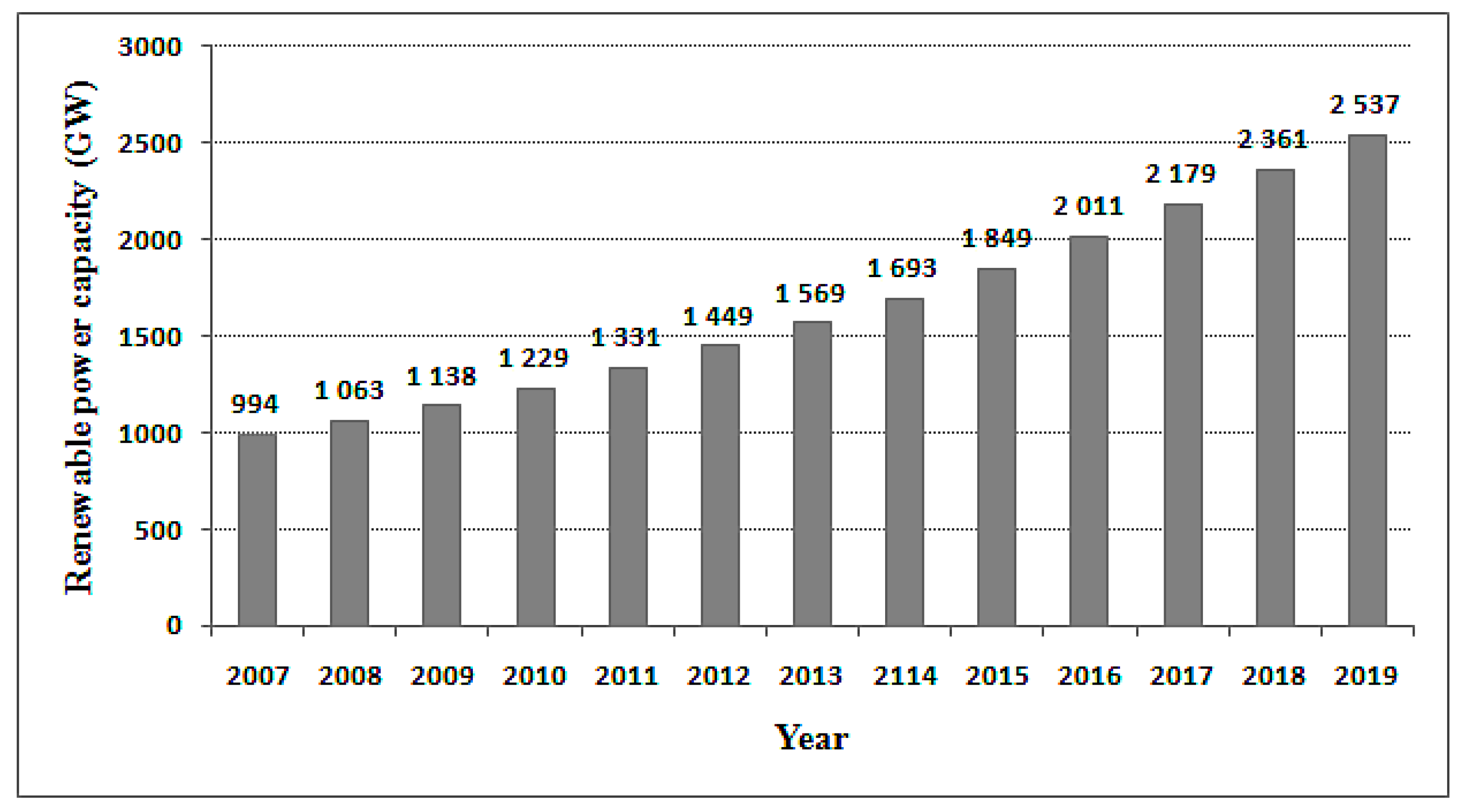
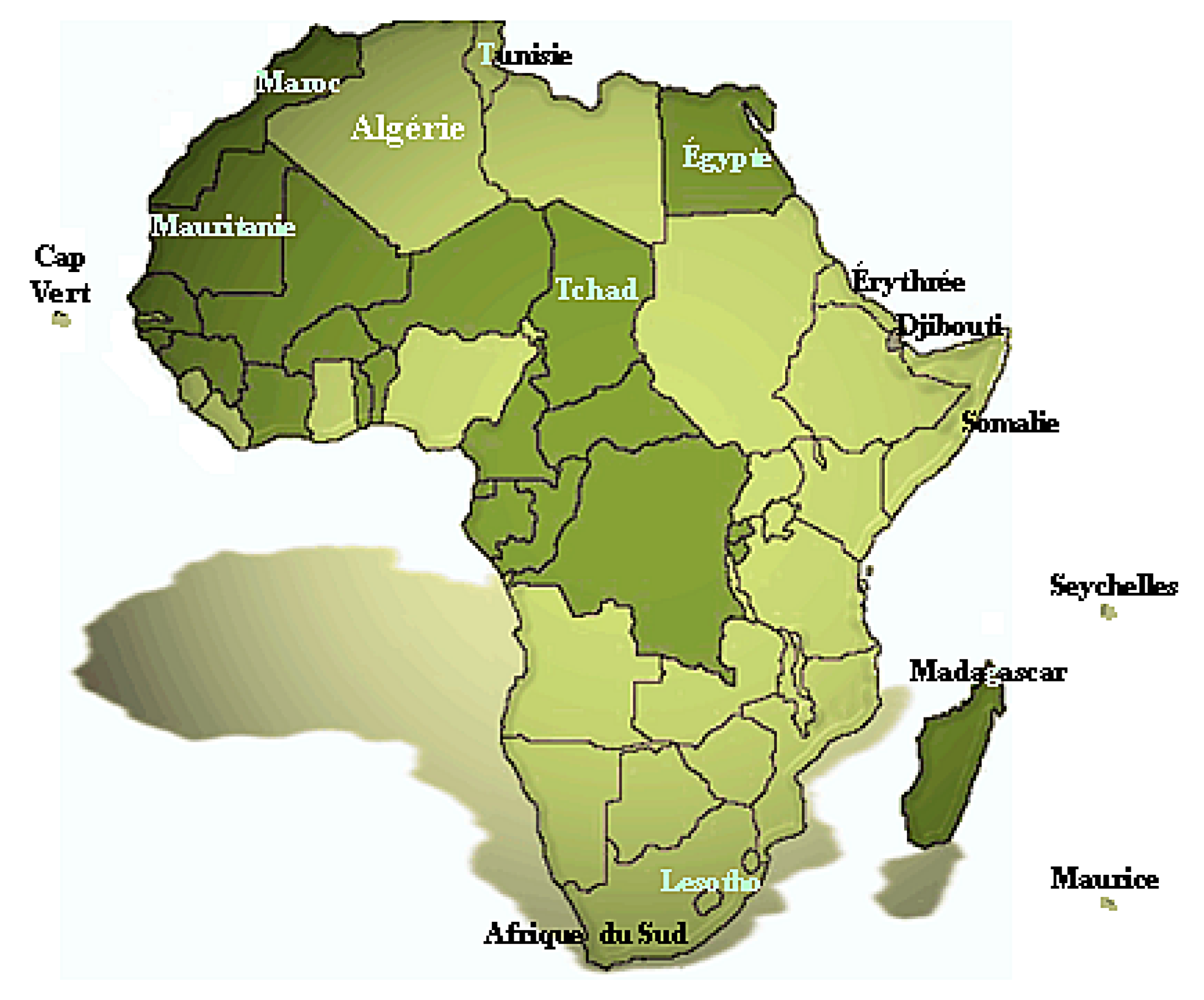
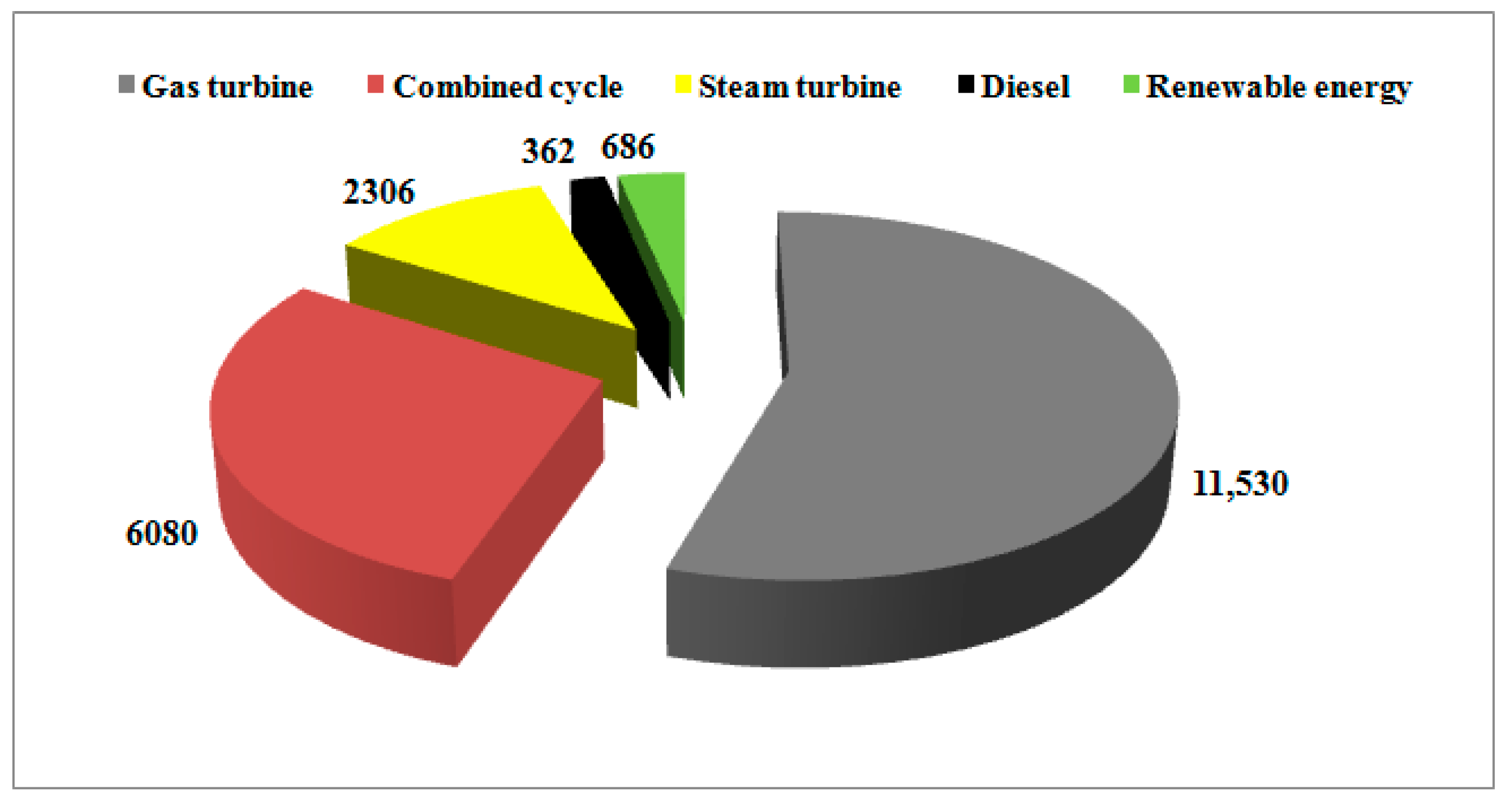
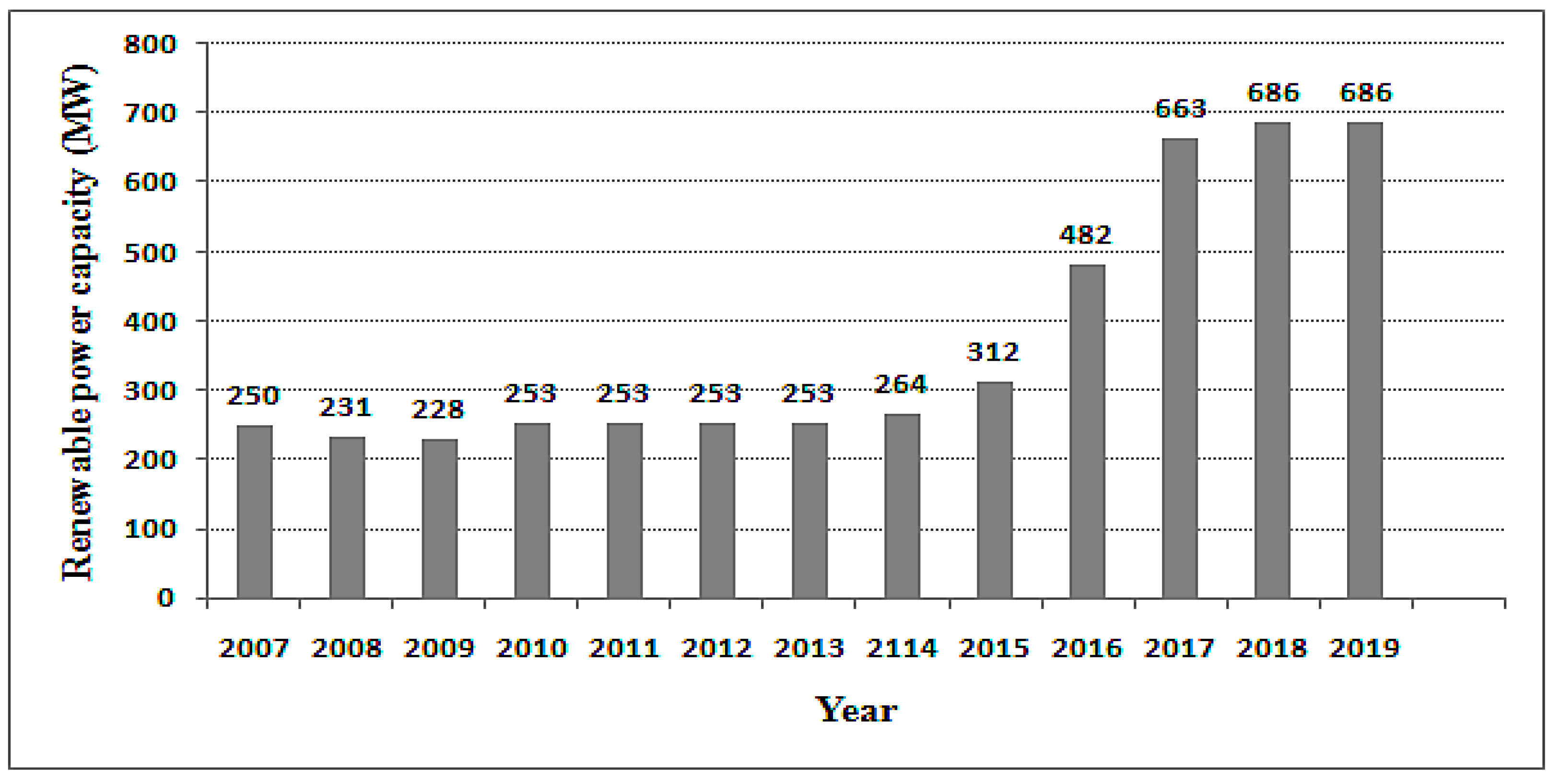
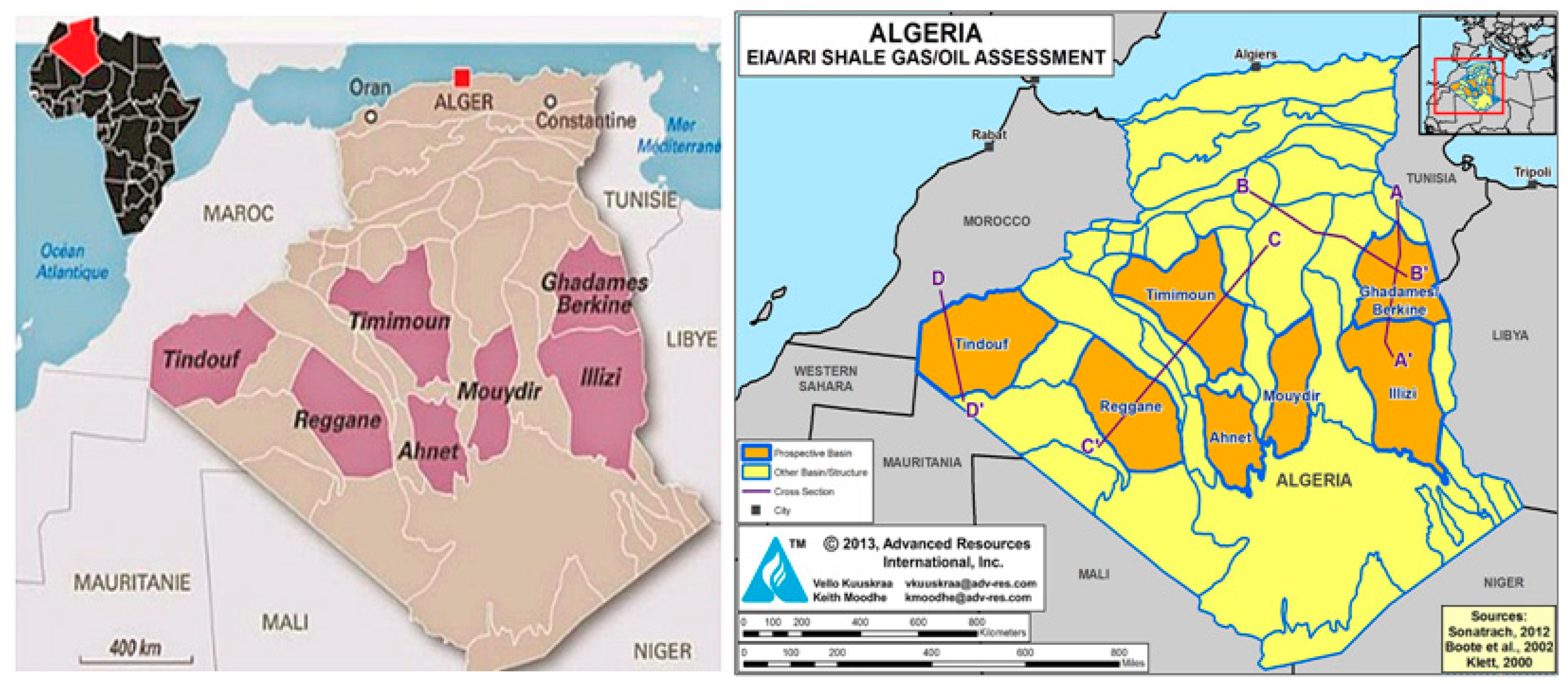
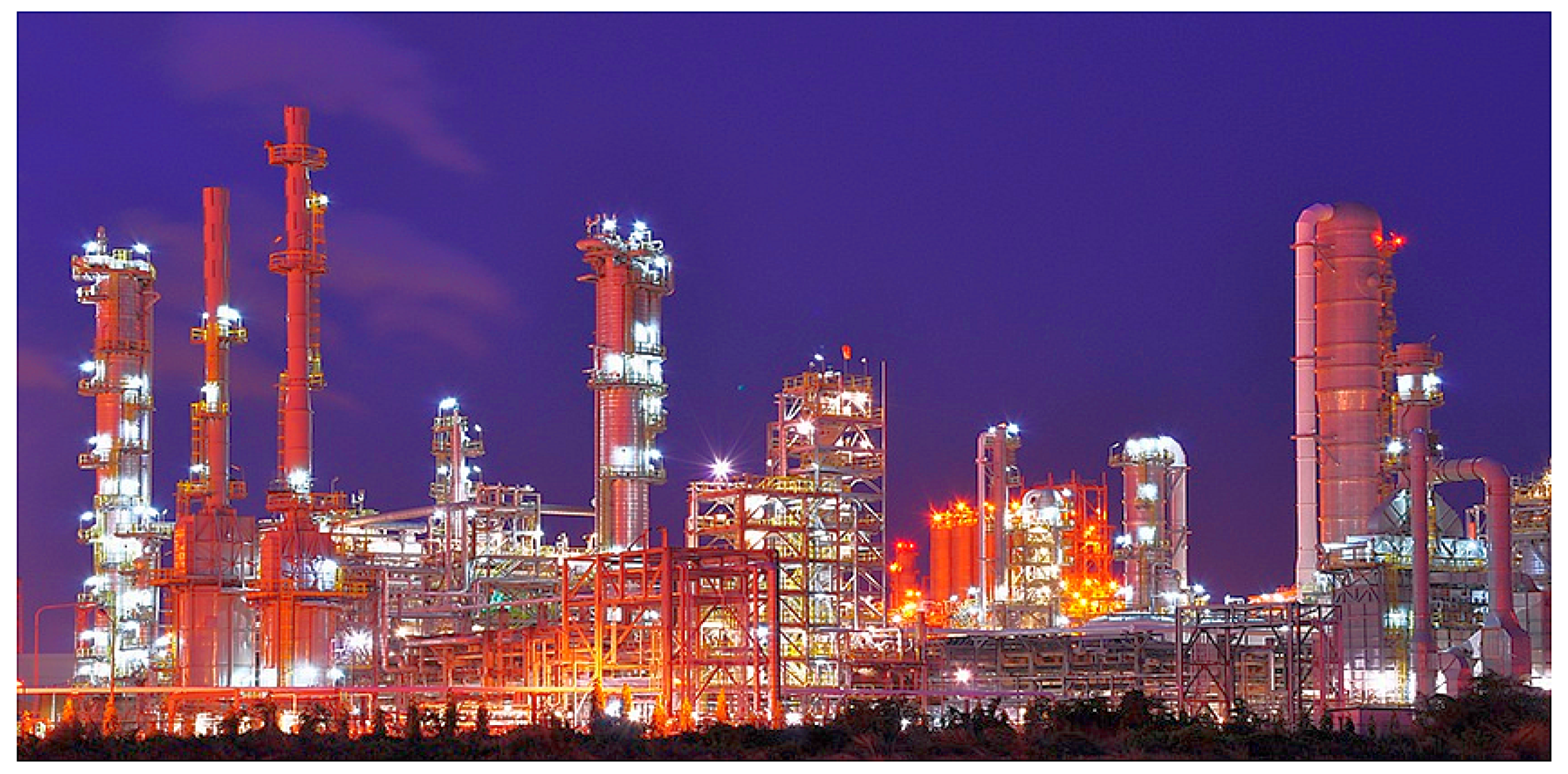
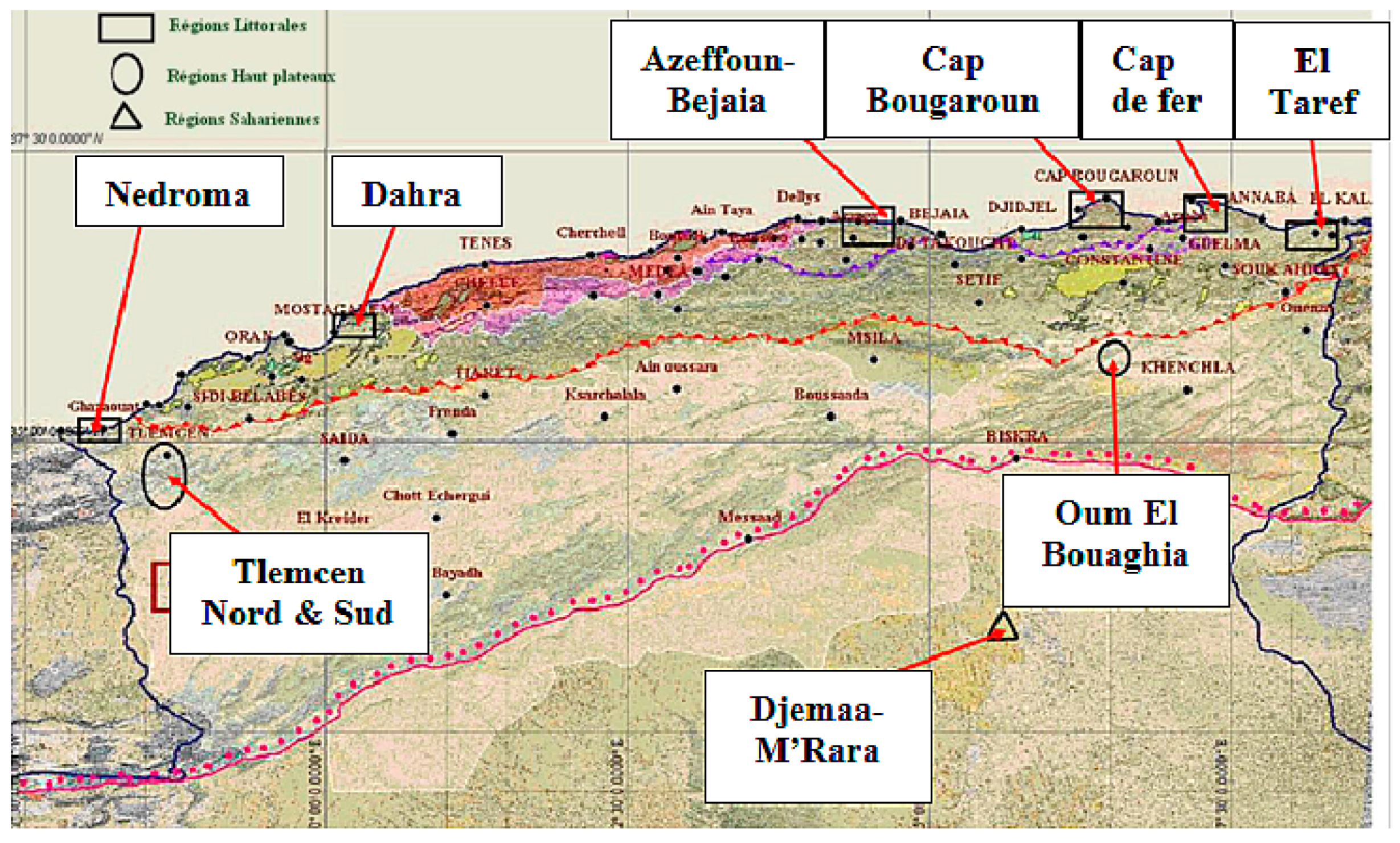
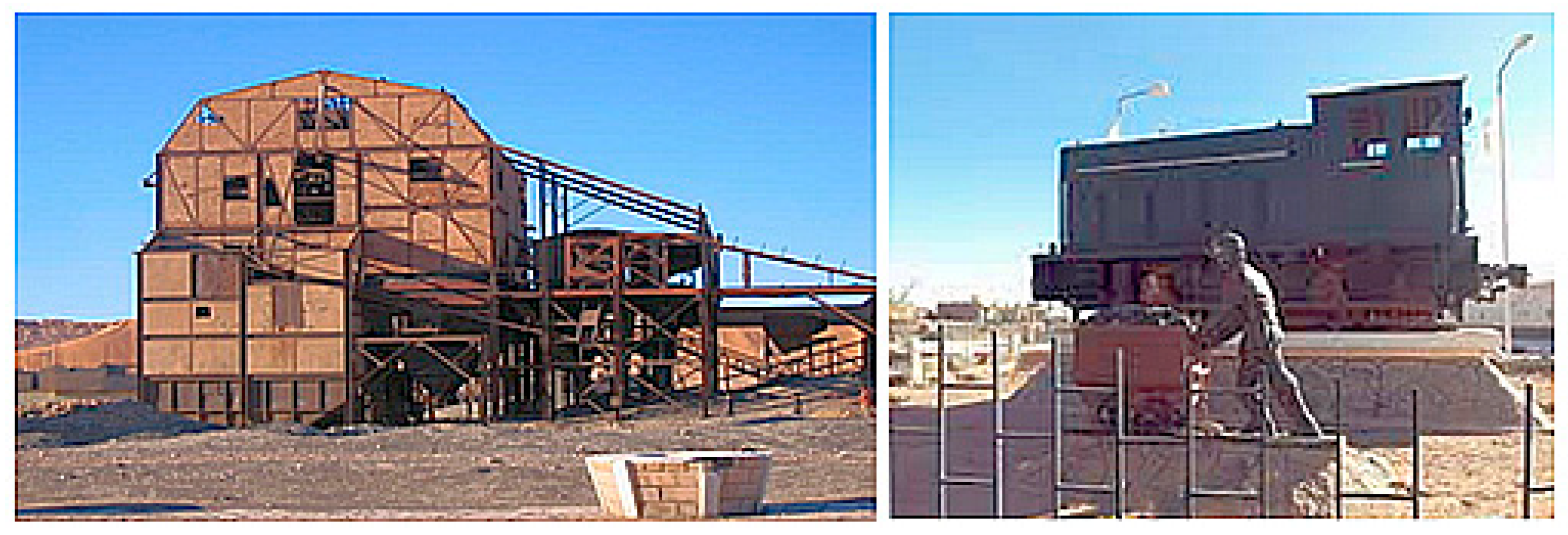
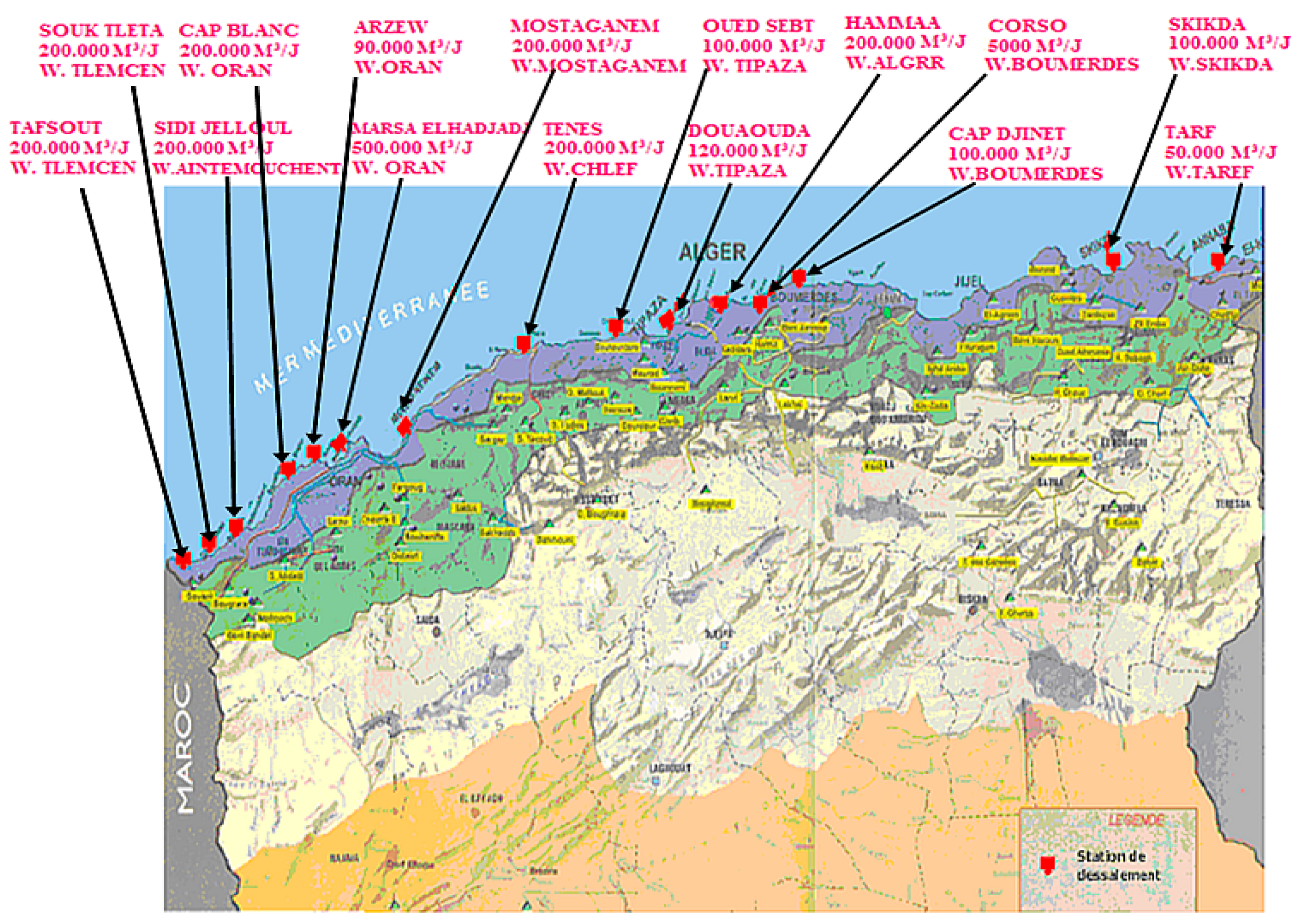
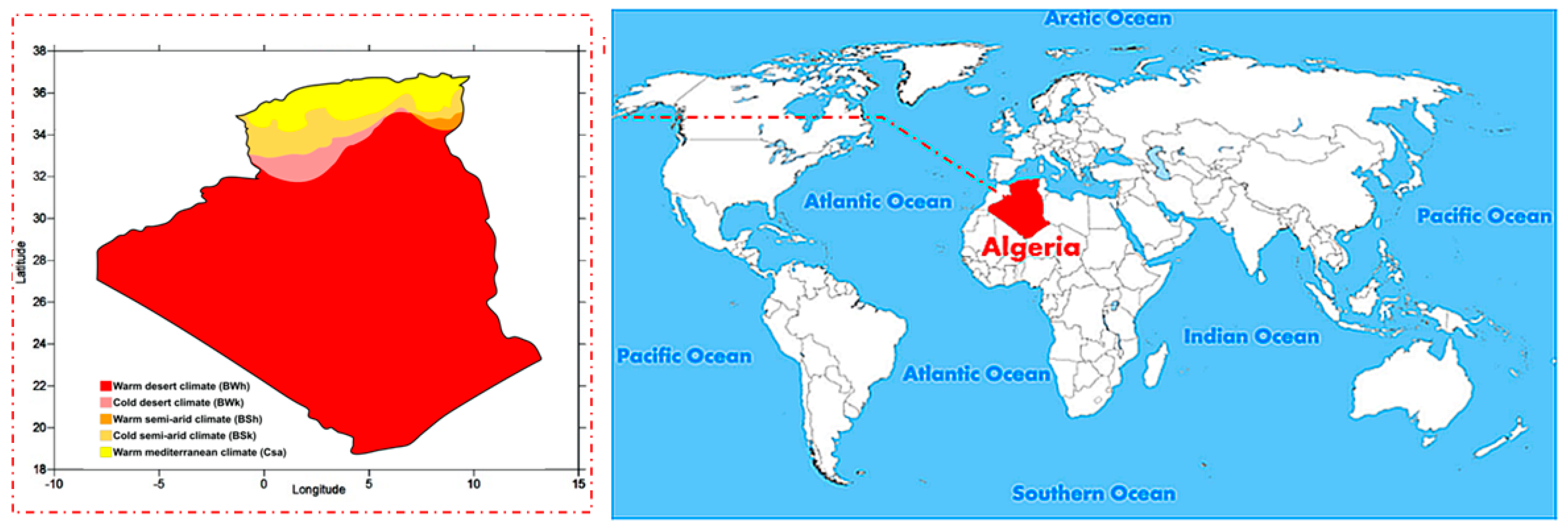
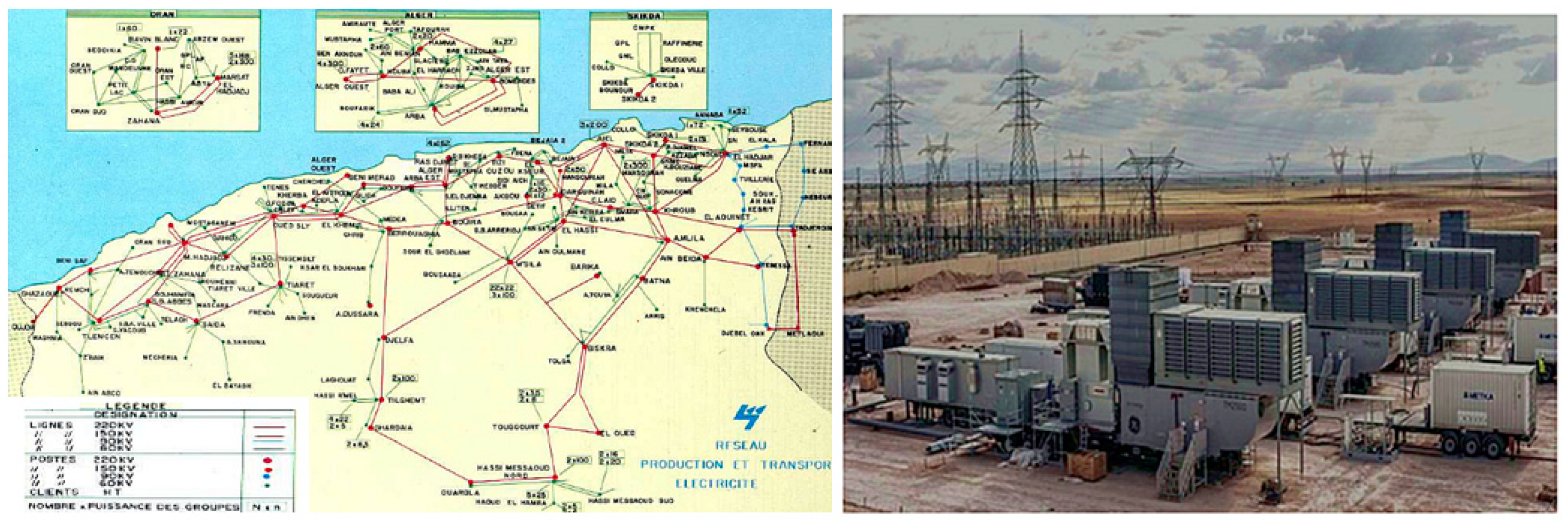

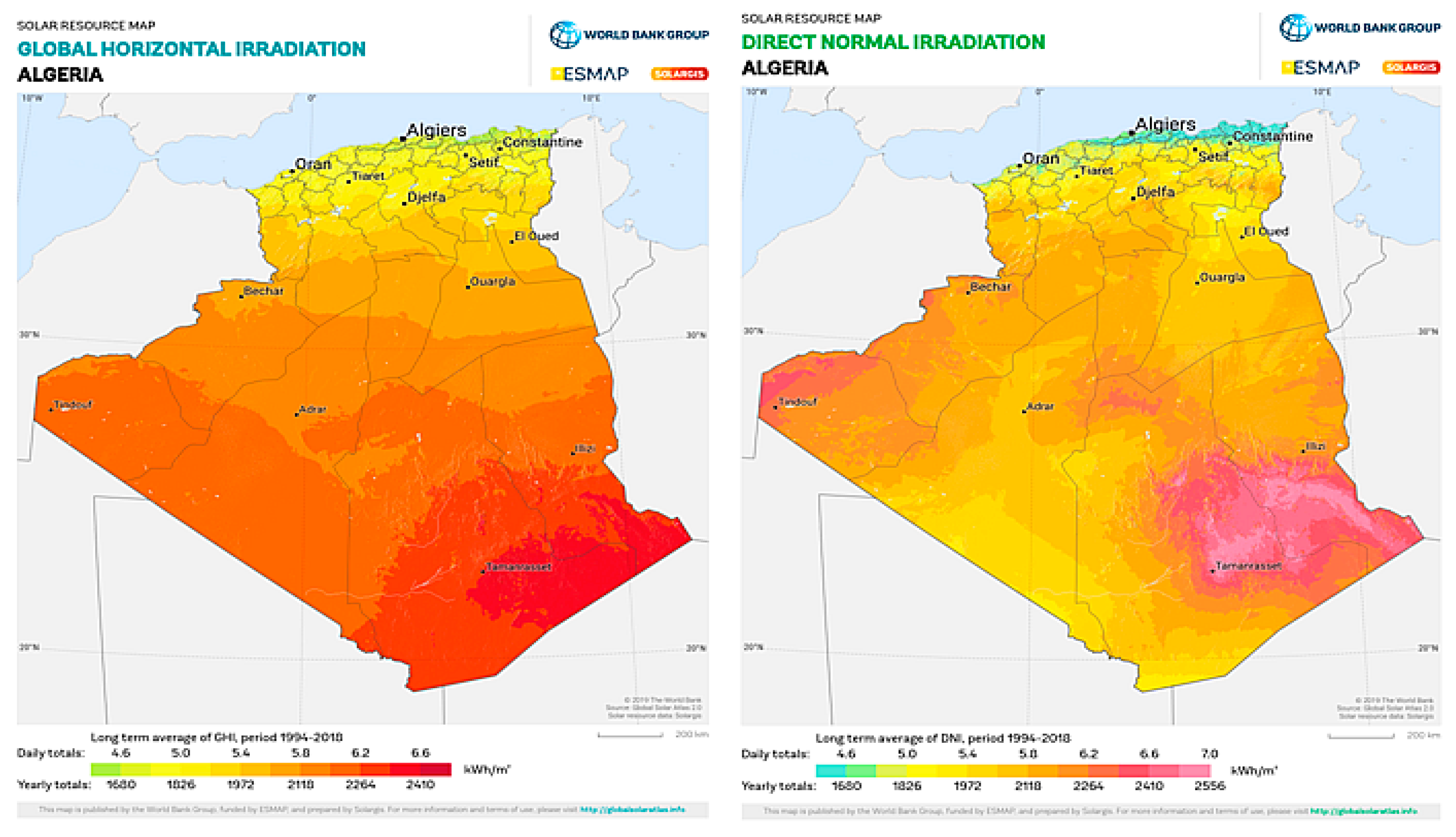
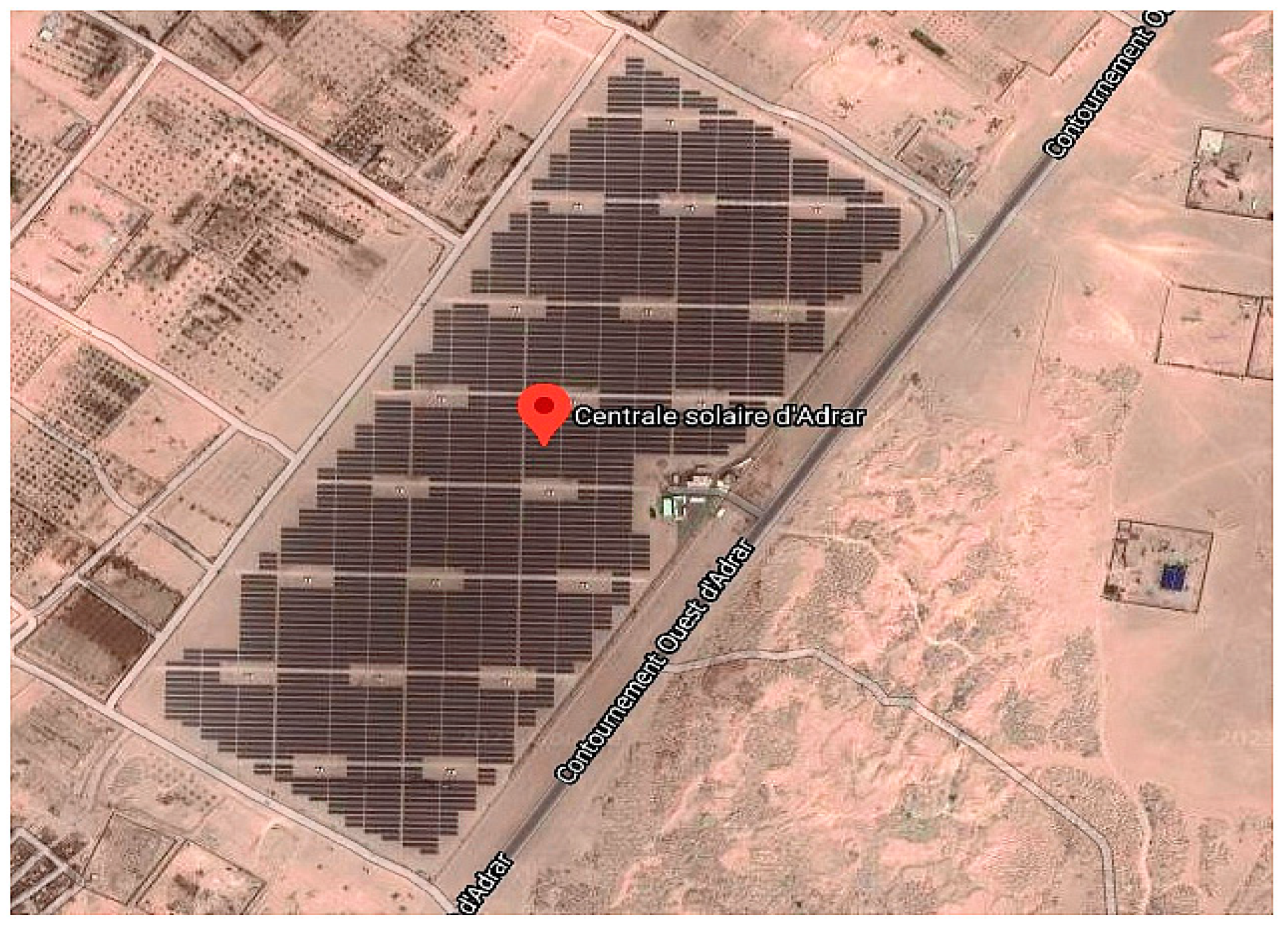
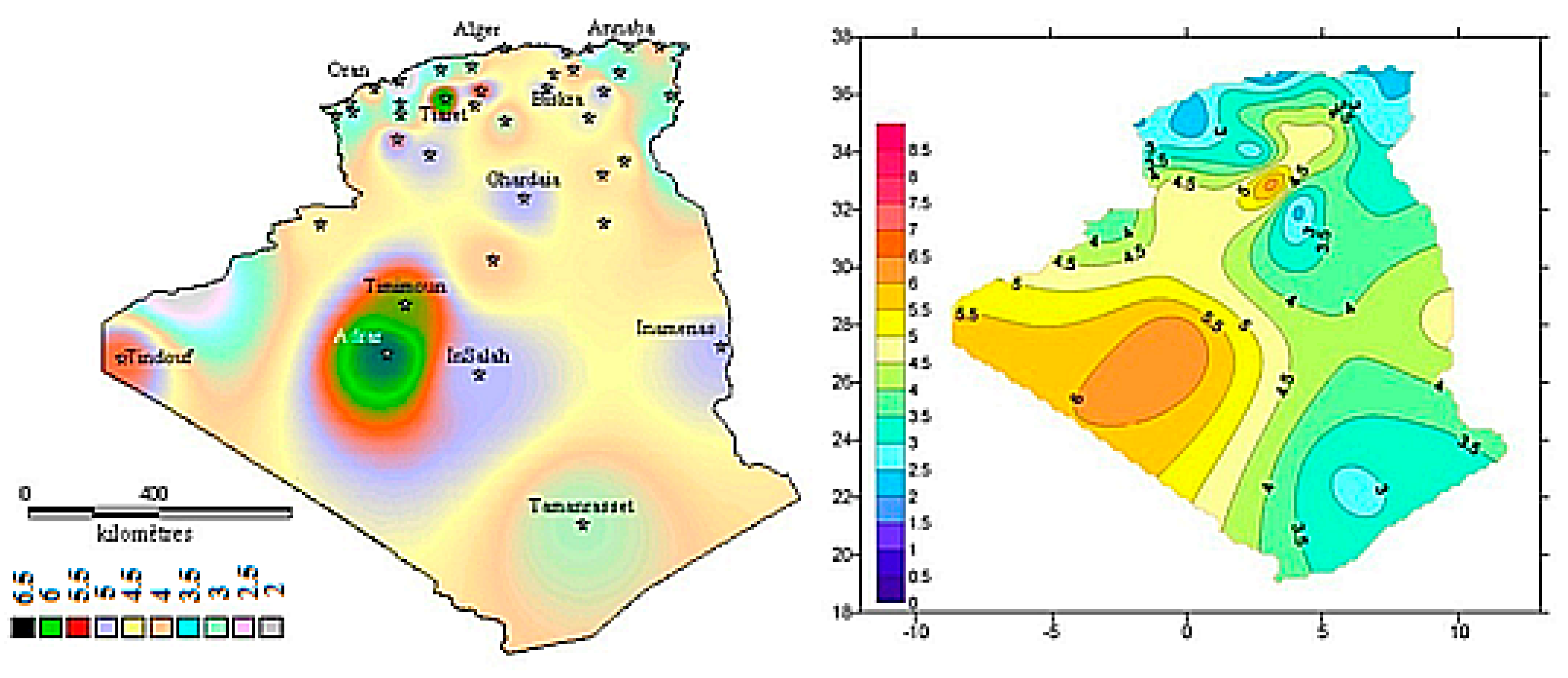
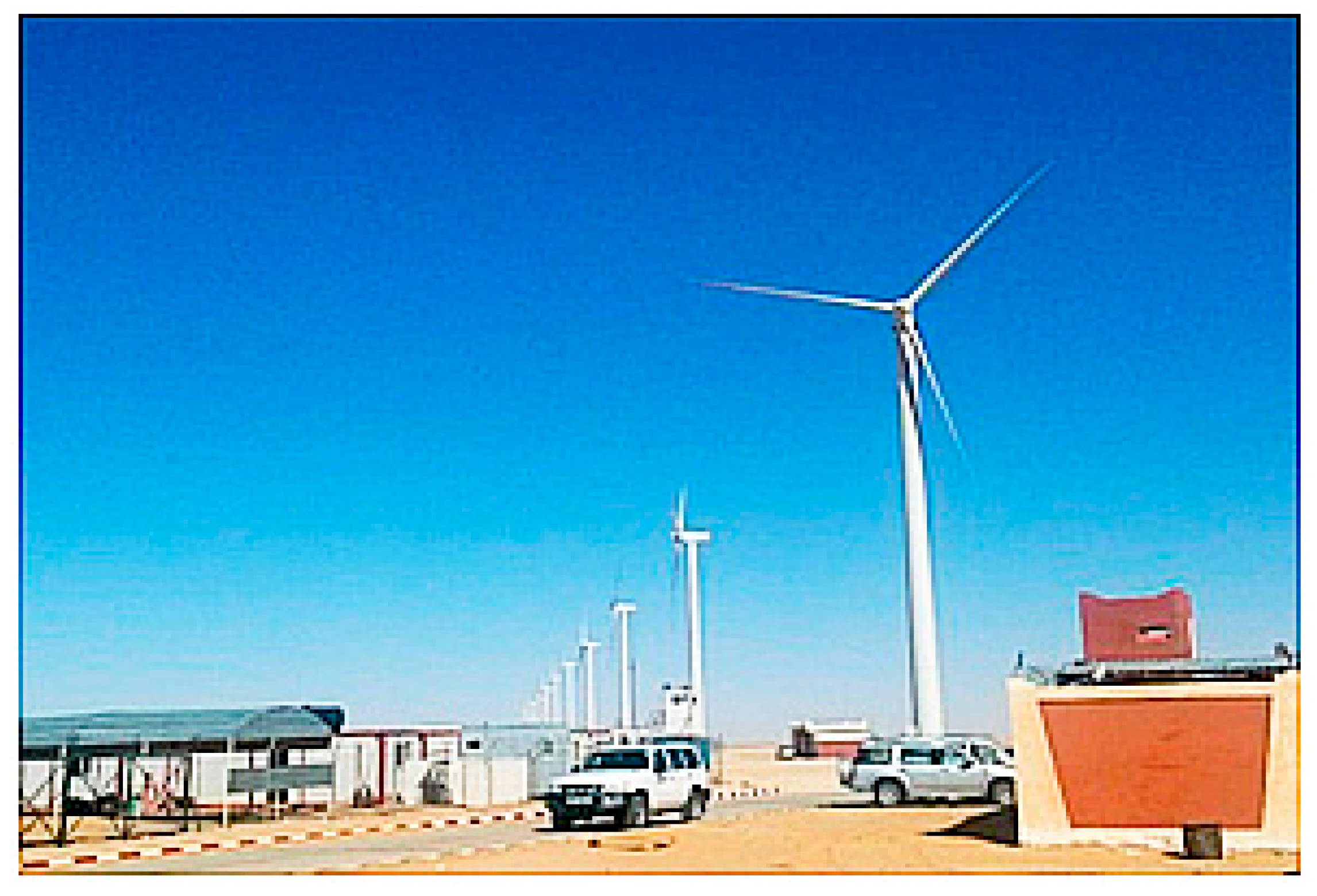
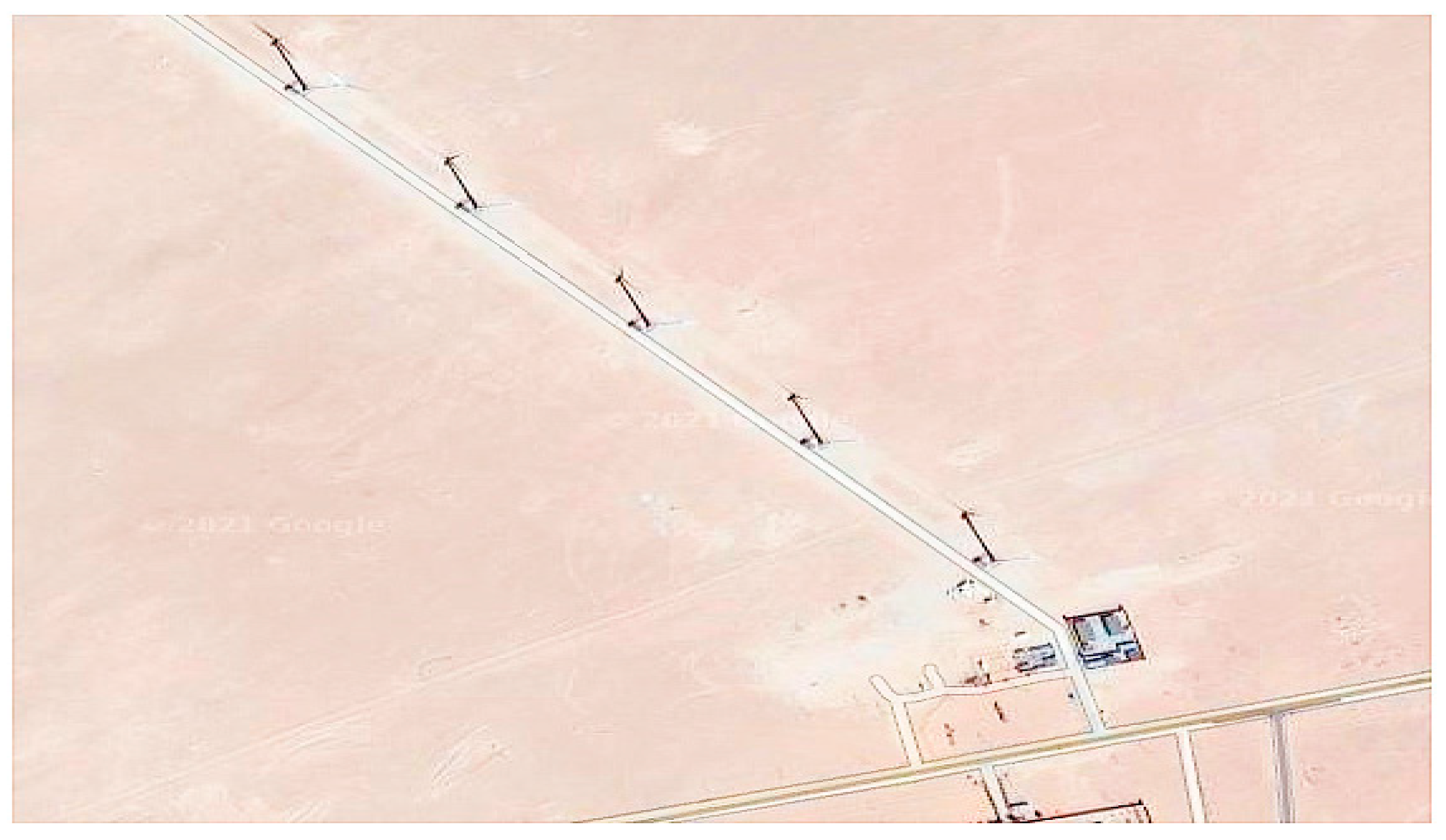
| Refinery | Capacity (kb/d) | Type |
|---|---|---|
| Skikda | 355 | Crude oil/condensate |
| Hassi Messaoud | 22 | Crude oil |
| Algiers (El Harrach) | 58 | Crude oil |
| Arzew | 75 | Crude oil |
| Adrar | 13 | Crude oil |
| Total | 523 | - |
| Energy Product (MTOE) | 2015 | 2016 | Evolution (%) | Share of Total Primary Energy Production (%) |
|---|---|---|---|---|
| Natural gas | 79.931 | 89.731 | +12.3 | 54.0 |
| Crude oil | 54.250 | 56.193 | +3.6 | 33.8 |
| Condensate | 10.885 | 10.449 | −4.0 | 6.3 |
| LPG | 9.753 | 9.726 | −0.3 | 5.8 |
| Primary electricity | 0.053 | 0.080 | +51.1 | 0.1 |
| Solids fuels: wood | 0.006 | 0.006 | −3.1 | |
| Total | 154.878 | 166.185 | +7.3 | 100 |
| Year | 2006 | 2007 | 2008 | 2009 | 2010 | 2011 | 2012 | 2013 | 2014 | 2015 | 2016 |
|---|---|---|---|---|---|---|---|---|---|---|---|
| Total of primary energy consumption MTOE | 33.8 | 35.6 | 37.7 | 39.9 | 38.9 | 41.3 | 45.1 | 47.8 | 51.6 | 55.1 | 55.1 |
| Oil | Natural Gas | Coal | Nuclear Energy | Hydro-Electricity | Renewables | Total | |
|---|---|---|---|---|---|---|---|
| 2015 (MTOE) | 19.5 | 35.5 | 0.1 | - | Less than 0.05 | Less than 0.05 | 55.1 |
| 2016 (MTOE) | 18.9 | 36.0 | 0.1 | - | Less than 0.05 | 0.1 | 55.1 |
| Location | Year of Construction | River | Dam Height (m) | Capacity (106 m3) | Reservoir Area (km2) | Purpose | Age Dam till 2020 (Years) |
|---|---|---|---|---|---|---|---|
| AinDefla | 1938 | Chelif | 105 | 280 | 11.985 | Power Generation (PG) | 82 |
| Batna | 2003 | Rbôa | - | 65 | - | Irrigation/Water Supply(I/W.S) | 17 |
| Bechar | 1968 | Guir | 38 | 350 | 57.15 | I/W.S | 52 |
| Biskra | 1950 | El Abiod | 73 | 47 | 3.256 | PG | 70 |
| Biskra | 2000 | El Hai | 42 | 55 | - | I/W.S | 20 |
| Mila | 2003 | Kebir | 120 | 1000 | - | I/W.S | 17 |
| Chlef | 1932 | Fodda | 101 | 228 | 7 | PG | 88 |
| Bouira | 2006 | Isser | 120 | 640 | - | I/W.S | 14 |
| Boumerdes | 1985 | Boudouaou | 108 | 145.6 | 5.2 | I/W.S | 35 |
| Chlef | 1983 | Sly | 87 | 280 | 8.85 | I/W.S | 37 |
| El Bayadh | 2001 | Mouilah | - | 122.5 | - | I/W.S | 19 |
| Bejaia | 1954 | Agrioum | 76 | 160 | - | PG | 66 |
| El Tarf | 1965 | B. Namoussa | 50 | 171 | 9.87 | I/W.S | 55 |
| Guelma | 1987 | BouHamdane | 93 | 220 | 11 | I/W.S | 33 |
| Khenchela | 1985 | Babar | - | 41 | - | I/W.S | 35 |
| Mascara | 1948 | El Hammam | 99 | 73 | 5.369 | PG | 72 |
| Mascara | 1985 | Sahouat | 60 | 100 | 7 | I/W.S | 35 |
| Medea | 1934 | NaharOuasel | 14 | 55 | 24 | I/W.S | 86 |
| Jijel | 1963 | DjenDjen | 82 | 200 | - | PG | 57 |
| Mila | 2003 | Kebir | 120 | 1000 | - | I/W.S | 17 |
| M’sila | 1939 | Ksob | 46 | 29.5 | - | I/W.S | 81 |
| Relizane | 1988 | OuedRhiou | 70 | 450 | 21 | I/W.S | 32 |
| S. Ahras | 1995 | Cherf | - | 157 | - | I/W.S | 25 |
| Mostaganem | 2011 | Kerrada | - | 50 | - | I/W.S | 9 |
| Skikda | 1984 | Fessa | 60 | 125 | 10 | I/W.S | 36 |
| Tiaret | 1935 | Mina | 60 | 56 | 4.575 | PG | 85 |
| Tipaza | 1992 | El Hachem | - | 97 | - | I/W.S | 28 |
| Tissemsilet | 2004 | OuedFodda | - | 75 | - | I/W.S | 16 |
| TiziOuzou | 2001 | OuedAissi | - | 175 | - | I/W.S | 19 |
| Tlemcen | 1946 | Tafna | 55 | 63 | 3.412 | PG | 74 |
| Tlemcen | 1999 | Tafna | - | 177 | - | I/W.S | 21 |
| Location | Capacity (103 m3/Day) | Amount (106 USD) | Disposal Cost USD/m3 | Elevation (m) | Energy Consumed kWh/m3 |
|---|---|---|---|---|---|
| Skikda | 100 | 136 | 0.7398 | 8 | 3.56 |
| Kahrama | 90 | 400 | 0.8500 | Electric Generation 343 MWh | |
| Cap Djenet | 100 | 138 | 0.7257 | −2 | 3.7 |
| Souk Tlata | 200 | 251 | 0.7725 | - | |
| El Tarf | 100 | - | 0.89 | - | |
| Honaine | 200 | 291 | 0.8299 | 23 | 4.42 |
| Mostaganem | 200 | 227 | 0.7257 | 8 | ≤3.40 |
| Ténès | 200 | 231 | 0.5885 | 0 | - |
| Fouka | 120 | 180 | 0.7505 | 6 | ≤4 |
| Maqtaa | 500 | 492 | 0.5577 | 4 | 3.2 |
| Hamma | 200 | 258 | 0.8521 | 0 | 4 |
| BeniSaf | 200 | 240 | 0.6994 | 10 | ≤4.15 |
| Oued Sebt | 100 | 115 | 0.6794 | - | - |
| Jijel | 100 (Planning) | - | - | - | - |
| Bejaia | 100 (Planning) | - | - | - | - |
| SWRO | pH | T (°C) | NO3− mg/L | HCO3− mg/L | Ca+2 mg/L | Mg+2 mg/L | Cl− mg/L | K+ mg/L | SO4−2 mg/L | B mg/L | Fe+2 mg/L | TDS g/L |
|---|---|---|---|---|---|---|---|---|---|---|---|---|
| Cap Djinet | 8.22 | 15.7 | 6.33 | 130 | 381 | 724.0 | 6472.2 | 142.15 | 1023.4 | 3.81 | 0.085 | 35.7 |
| Hamma | 7.8 | 17.8 | 5.9 | 135 | 200 | 780.9 | 6816.0 | 148.8 | 1260.0 | 3.72 | 0.078 | 35.2 |
| Fouka | 7.7 | 15.6 | 5.8 | 134 | 220 | 807.0 | 6532.0 | 145.7 | 1100.0 | 3.46 | 0.09 | 36.1 |
| Mostaganem | 7.6 | 18.1 | 5.1 | 131 | 237 | 776.9 | 6453.6 | 144.9 | 1180.1 | 3.51 | 0.082 | 36.6 |
| Location | Capacity (103 m3/Day) | Population to Serve |
|---|---|---|
| Zéralda | 5 | 33,330 |
| Staoueli | 2.5 | 16,660 |
| AinBenian | 5 | 33,330 |
| Ghazaouet | 5 | 33,330 |
| Bou Ismail | 5 | 33,330 |
| L.BenMhidi | 7 | 33,330 |
| Tigzirt | 2.5 | 47,000 |
| Bousfer | 5 | 16,660 |
| Ain Turk | 2 × 2.5 | 33,330 |
| BouZdjer | 5 | 33,330 |
| BouZdjer | 5 | 33,330 |
| Corso | 5 | 33,330 |
| Zone | Cities Covered | Tariff Water Pricing (DA/m3) |
|---|---|---|
| Algiers | Algiers-Boumerdès-Tipaza-Blida-Medea-TiziOuzou-M’Sila-BordjBouArréridj-Bouira-Setif-Bejaia. | 6.30 |
| Oran | Oran-Mascara-Mostaganem-Tlemcen-Ain Témouchent-Saida-Sidi Bel Abbès-El Bayadh-Naama. | |
| Constantine | Constantine-Khenchela-Batna-Mila-Jijel-Annaba -Biskra-Souk Ahras-Guelma-El Tarf-Skikda-Oum El Bouaghi-Tebessa. | |
| Chlef | Chlef-Tiaret-Relizane-Ain Defla-Djelfa-Tissemsilt. | 6.10 |
| Ouargla | Ouargla-Adrar-Laghouat-Illizi-El Oued-Tindouf-Béchar-Tamanarest-Ghardaia. | 5.8 |
| Renewable Sources | First Stage 2015–2020 | Second Stage 2021–2030 | Total (MW) |
|---|---|---|---|
| Photovoltaic | 3000 | 10,575 | 13,575 |
| Wind energy | 1010 | 4000 | 5010 |
| CSP | - | 2000 | 2000 |
| Cogeneration | 150 | 250 | 400 |
| Biomass | 360 | 640 | 1000 |
| Geothermal | 05 | 10 | 15 |
| Total (MW) | 4525 | 17,475 | 22,000 |
| Site | Region | Area Project (km2) | Installed Capacity (MW) | Energy Output at June 2017 (GWh) | Commissioning Date |
|---|---|---|---|---|---|
| El Hadjira | Ouargla | 0.6 | 30 | 9.738 | 2017 |
| Oued Nechou PV | Ghardaia | 0.05 | 1.1 | 4.593 | 2014 |
| Tindouf | Tindouf | 0.18 | 09 | 6.376 | 2015 |
| Djanet | Illizi | 0.06 | 03 | 10.729 | 2015 |
| Tamanrasset | Tamanrasset | 0.26 | 13 | 36.410 | 2015 |
| Aoulef | Adrar | 0.1 | 05 | 12.557 | 2016 |
| Zaouiate Kounta | 0.12 | 06 | 15.213 | 2016 | |
| Reggane | 0.1 | 05 | 12.221 | 2016 | |
| Timimoune | 018 | 09 | 23.8222 | 2016 | |
| In Salah | 0.1 | 05 | 12.328 | 2016 | |
| Kaberten (PV) | 0.06 | 03 | 9.584 | 2015 | |
| Adrar | 0.4 | 20 | 59.585 | 2015 | |
| Kaberten (wind farm) | 0.33 | 10.2 | 51.579 | 2014 |
| Regions | North Country | Sahara | Unit | |
|---|---|---|---|---|
| Coast | High Plateaus | |||
| Area | 4 | 10 | 86 | % |
| Average sun duration | 2650 | 3000 | 3500 | hours/year |
| Average annual energy received | 1700 | 1900 | 2650 | kWh/m2 |
| Average GHI | 2100 | 2100 | 2400 | kWh/m2/year |
| Item | Details |
|---|---|
| Type | Polycrystalline |
| Pm | 245 W |
| Amperage | |
| Imp | 8.28 A |
| Isc | 8.83 A |
| Voltage | |
| Vmp | 29.6 V |
| Voc | 37.5 V |
| Input DC | |
| Vmax | 1000 V |
| VStart-up | 500 V |
| VMPPT | 460~850 V |
| Vmin | 460 V |
| Pmax | 560 kW |
| Imax | 1220 A |
| Output AC | |
| Pnominal | 500 kW |
| Pmax | 550 kW |
| Imax | 1008 A |
| Vnominal | 315 V |
| cosφ | 0.9 (Inductive/Capacitive) |
| Rated power | 1250 kVA |
| Vector group | Dy11y11 |
| Short circuit impedance | 6.28% |
| Primary side | |
| Rated voltage | 2 × 315 V |
| Rated current | 2 × 1146 A |
| Secondary side | |
| Rated voltage | 30 kV |
| Rated current | 24.1 A |
| Month | Temperature (°C) | Solar Radiation (kWh/m2) | Wind Speed (m/s) | Energy Output (MWh) | Performance Ratio (%) | Capacity Factor (%) |
|---|---|---|---|---|---|---|
| January | 15.3 | 172.3 | 4.6 | 2813.2 | 82.4 | 20.3 |
| February | 16 | 180.5 | 4.3 | 2813.2 | 78.9 | 21 |
| March | 21.6 | 232.4 | 4.4 | 3450.6 | 74.7 | 23.2 |
| April | 26.2 | 224.2 | 5.1 | 3252.8 | 73.1 | 22.7 |
| May | 29.5 | 251.4 | 4.1 | 3230.8 | 64.8 | 21.8 |
| June | 35 | 243.1 | 4.8 | 2945.1 | 61 | 20.4 |
| July | 40.8 | 246.4 | 4.3 | 2725.3 | 55.8 | 18.4 |
| August | 33.9 | 225 | 4.7 | 2967 | 66.2 | 19.9 |
| September | 32.7 | 194.5 | 4.6 | 2813.2 | 72.5 | 19.6 |
| October | 25.7 | 181.3 | 3.6 | 2736.3 | 75.8 | 20.3 |
| November | 19.2 | 185.4 | 3.7 | 2945.1 | 79.7 | 20.4 |
| December | 14 | 202.8 | 4.7 | 3274.7 | 80.8 | 22 |
| Item | Value | Unit |
|---|---|---|
| Rated power | 850 | kW |
| Wind turbine rotor | 52 | m |
| Hub height | 55 | m |
| Number of blades | 3 | |
| Cut-in speed | 4 | m/s |
| Rated speed | 16 | m/s |
| Cut-off speed | 25 | m/s |
| Gearbox ratio | 3 stages; 1:61.74 | |
| Generator voltage | Double-fed induction 690 | V |
| Power factor | 0.95 Ind/Cap | |
| Control system | Pitch-regulated | |
| Operational temperature limits: | −30 to +50 | °C |
| Wind Farm | N° Wind Turbine | Production (kWh) | Capacity Factor “CF” (%) |
|---|---|---|---|
| Kabereten (Adrar) | WT01 | 2,250,284 | 30.22 |
| WT02 | 1,697,193 | 22.79 | |
| WT03 | 697,817 | 9.37 | |
| WT04 | 1,906,719 | 25.61 | |
| WT05 | 1,944,630 | 26.12 | |
| WT06 | 2,387,932 | 32.07 | |
| WT07 | 1,875,750 | 25.19 | |
| WT08 | 2,200,120 | 29.55 | |
| WT09 | 1,952,431 | 26.22 | |
| WT10 | 1,162,480 | 15.61 | |
| WT11 | 1,894,519 | 25.44 | |
| WT12 | 1,542,196 | 20.71 | |
| Total | 21,512,071 | 24.08 |
| Parameter | Jan | Feb | Mar | Apr | May | Jun | Jul | Aug | Sep | Oct | Nov | Dec | Ann |
|---|---|---|---|---|---|---|---|---|---|---|---|---|---|
| Max Temperature (°C) * | 19.2 | 22.1 | 25.9 | 36.2 | 39.9 | 42.3 | 44 | 45.1 | 39.3 | 33.9 | 26.5 | 21.9 | 33.1 |
| Min Temperature (°C) * | 4.7 | 7.4 | 9.5 | 18.9 | 22.7 | 25.5 | 28.2 | 30.4 | 26.4 | 21.4 | 13 | 7.5 | 18 |
| Max Wind Speed (m/s) ** | 5.9 | 6.5 | 7.3 | 6.5 | 6.6 | 7.7 | 7.3 | 6.7 | 6.1 | 5.8 | 6.8 | 6.5 | 6.7 |
| Wind Speed (m/s) ** | 4.1 | 4.1 | 4.8 | 4 | 4.4 | 5.3 | 5.3 | 4.4 | 3.9 | 3.6 | 5.1 | 5.1 | 4.5 |
| Min Wind Speed (m/s) ** | 2.4 | 2.1 | 2.8 | 1.9 | 2.3 | 3.4 | 3.5 | 2.4 | 1.8 | 1.9 | 3.4 | 3.5 | 2.6 |
| Relative Humidity RH (%) * | 33.7 | 31.1 | 22.6 | 12.1 | 11 | 11.4 | 12.2 | 14.7 | 22.8 | 30.6 | 35 | 39.4 | 23 |
| Surface Pressure PS (kPa) * | 99.1 | 98.3 | 98.4 | 98.2 | 97.9 | 97.9 | 97.8 | 97.8 | 98 | 98.2 | 98.8 | 99.4 | 98.3 |
| Wind Potential (TWh/Year) | ||
|---|---|---|
| All areas with wind turbine CF greater than 20% | All areas with wind turbine CF greater than 30% | All areas with wind turbine CF greater than 40% |
| 30,155 | 2535.9 | 153.4 |
Publisher’s Note: MDPI stays neutral with regard to jurisdictional claims in published maps and institutional affiliations. |
© 2022 by the authors. Licensee MDPI, Basel, Switzerland. This article is an open access article distributed under the terms and conditions of the Creative Commons Attribution (CC BY) license (https://creativecommons.org/licenses/by/4.0/).
Share and Cite
Himri, Y.; Rehman, S.; Mostafaeipour, A.; Himri, S.; Mellit, A.; Merzouk, M.; Merzouk, N.K. Overview of the Role of Energy Resources in Algeria’s Energy Transition. Energies 2022, 15, 4731. https://doi.org/10.3390/en15134731
Himri Y, Rehman S, Mostafaeipour A, Himri S, Mellit A, Merzouk M, Merzouk NK. Overview of the Role of Energy Resources in Algeria’s Energy Transition. Energies. 2022; 15(13):4731. https://doi.org/10.3390/en15134731
Chicago/Turabian StyleHimri, Youcef, Shafiqur Rehman, Ali Mostafaeipour, Saliha Himri, Adel Mellit, Mustapha Merzouk, and Nachida Kasbadji Merzouk. 2022. "Overview of the Role of Energy Resources in Algeria’s Energy Transition" Energies 15, no. 13: 4731. https://doi.org/10.3390/en15134731
APA StyleHimri, Y., Rehman, S., Mostafaeipour, A., Himri, S., Mellit, A., Merzouk, M., & Merzouk, N. K. (2022). Overview of the Role of Energy Resources in Algeria’s Energy Transition. Energies, 15(13), 4731. https://doi.org/10.3390/en15134731








